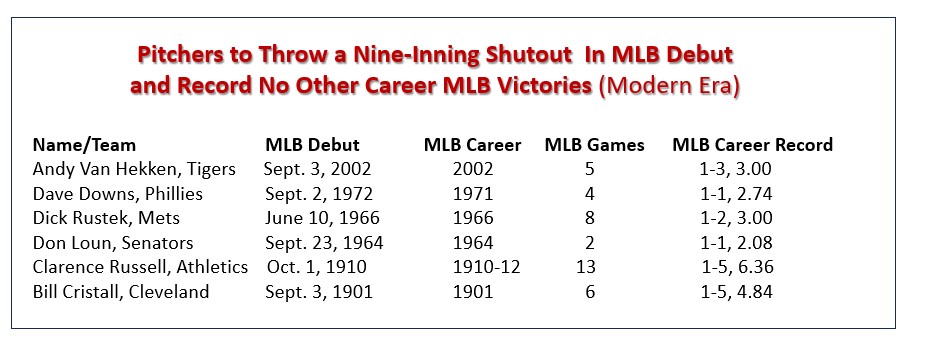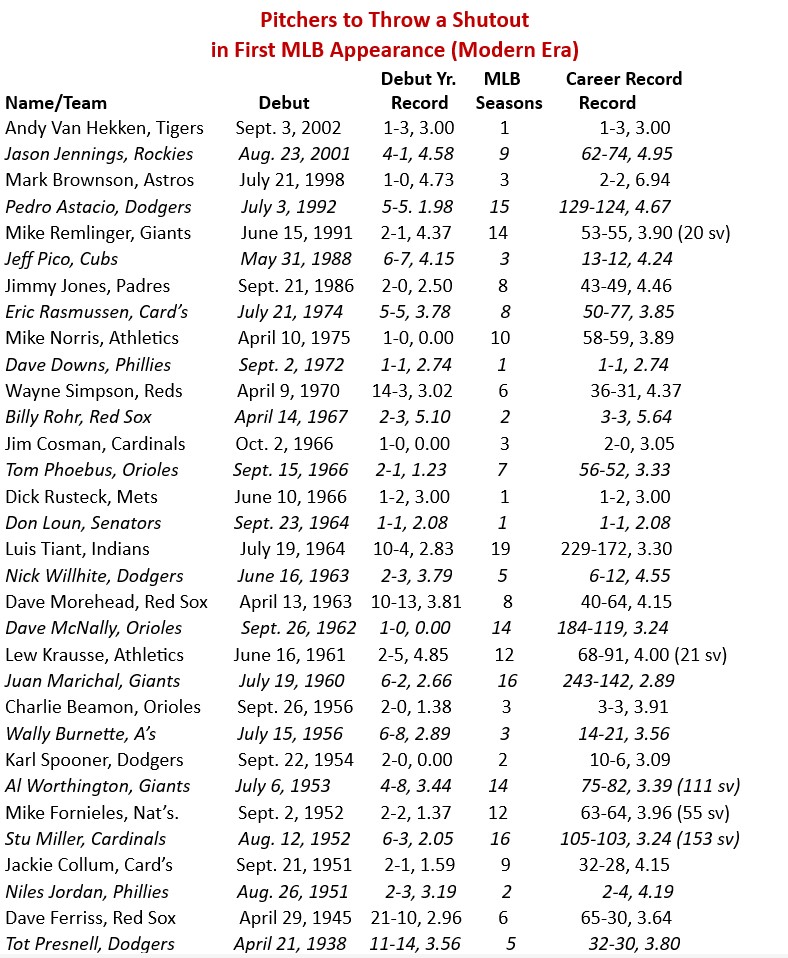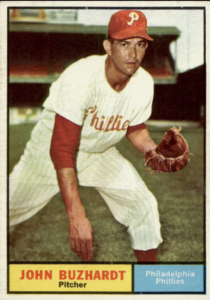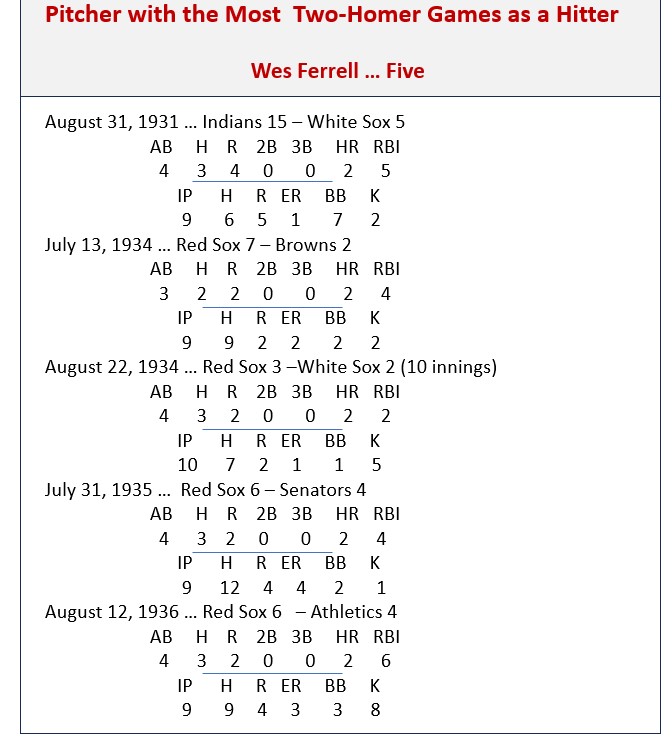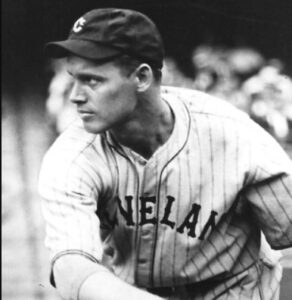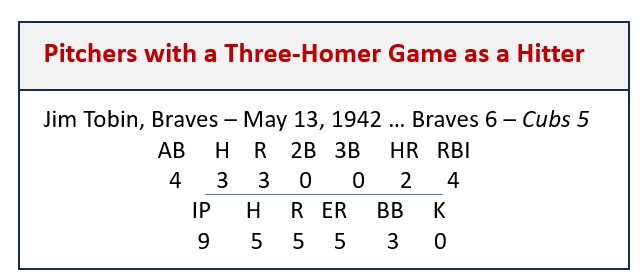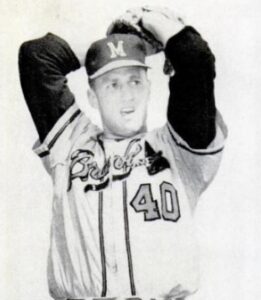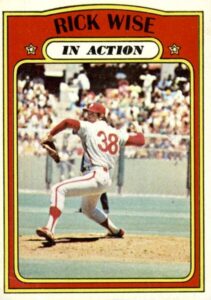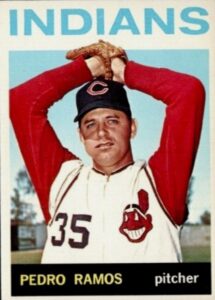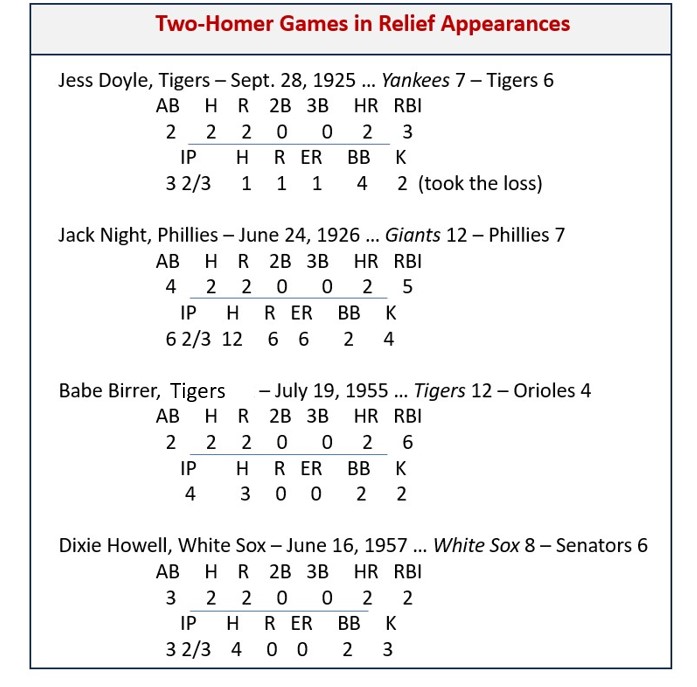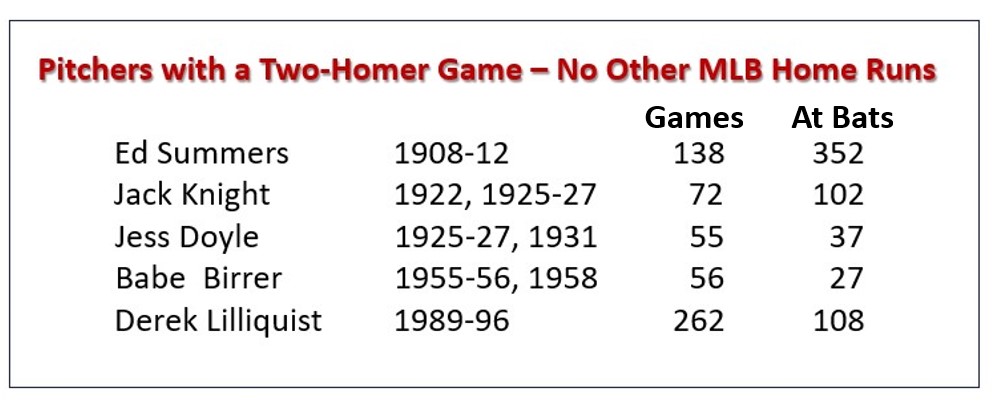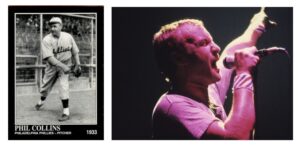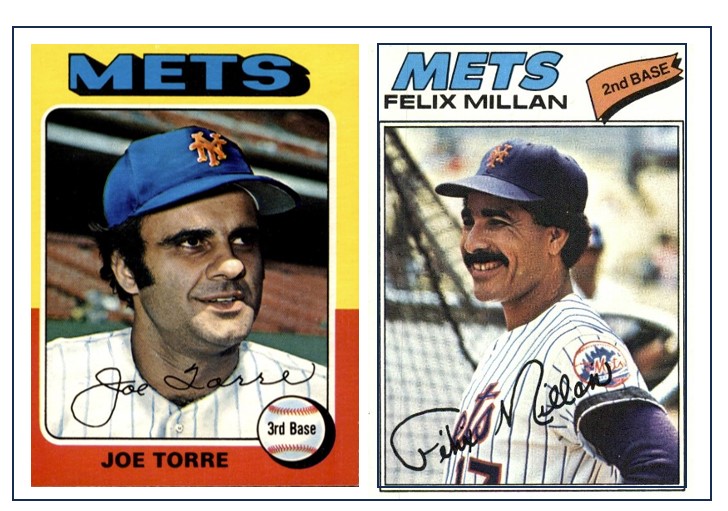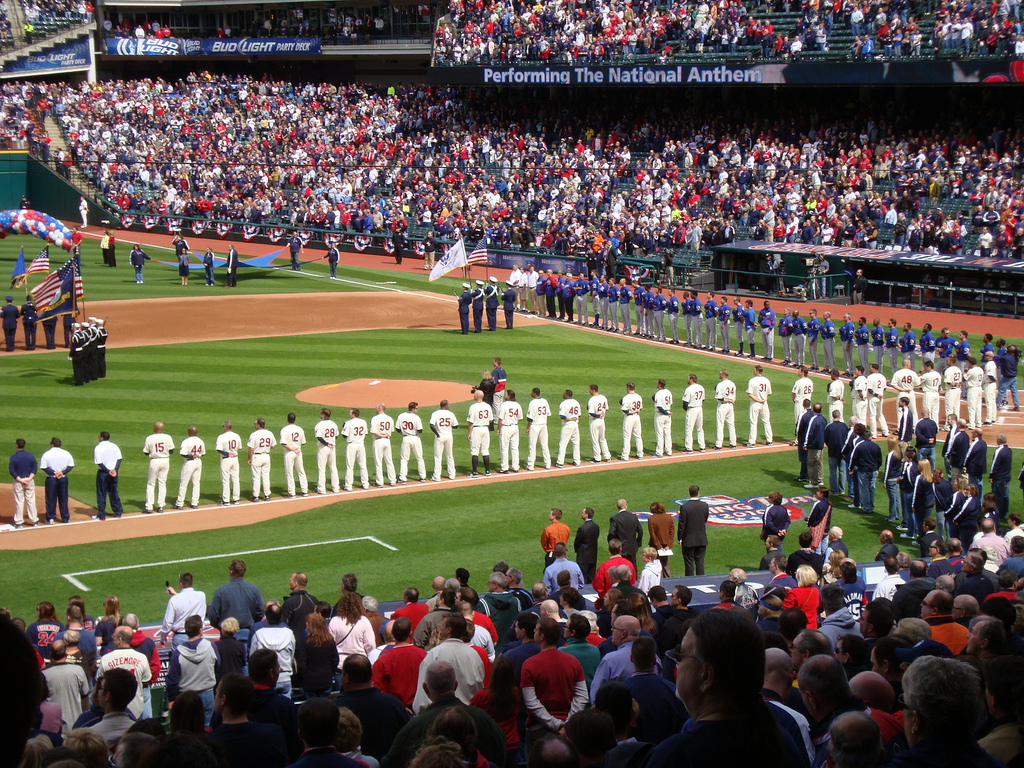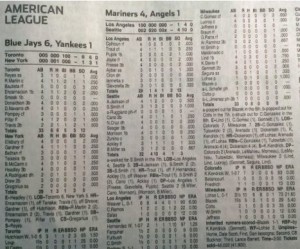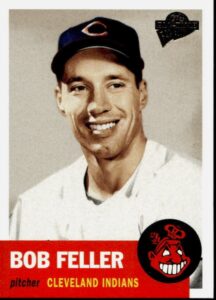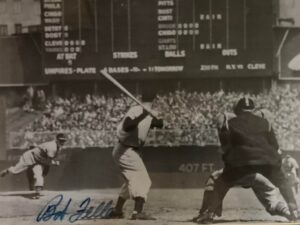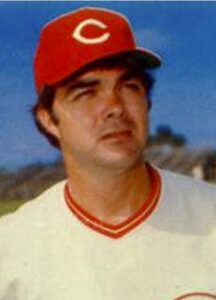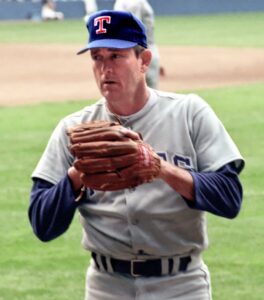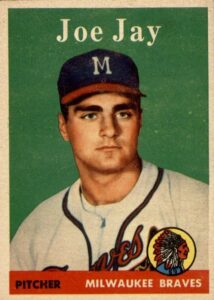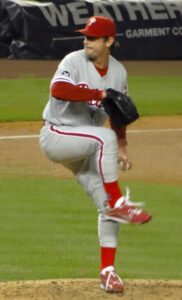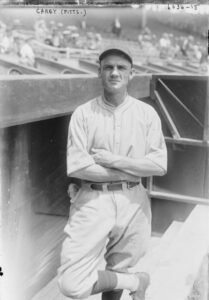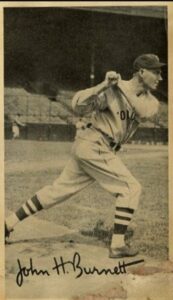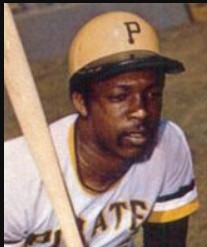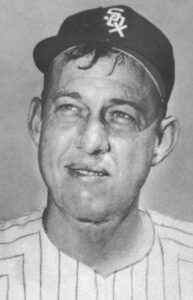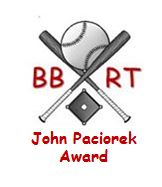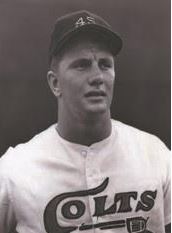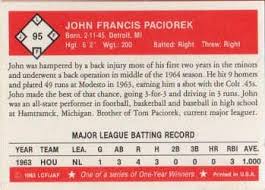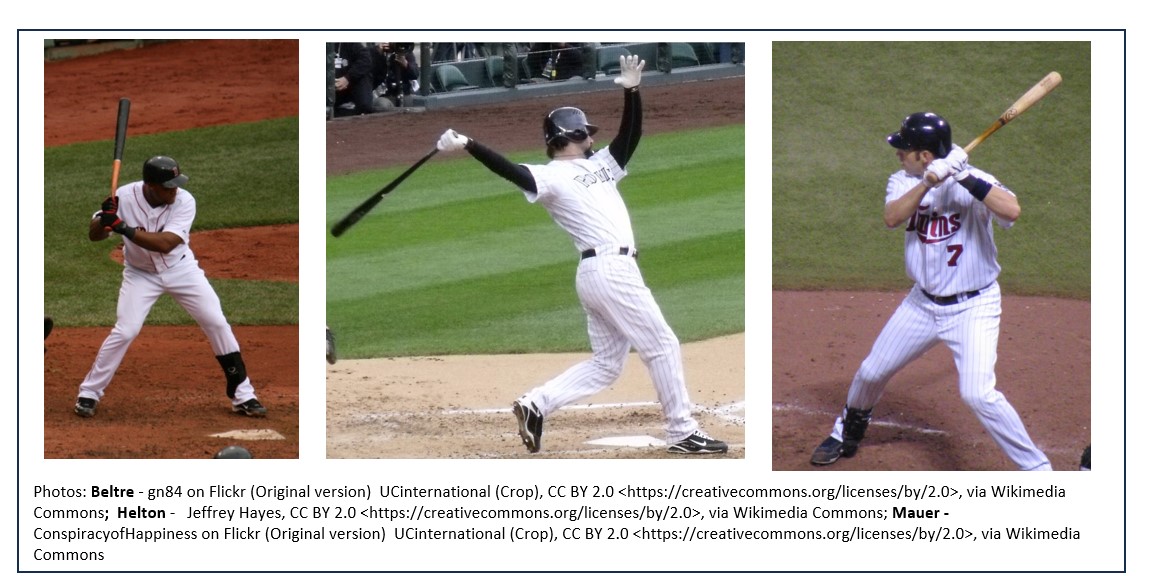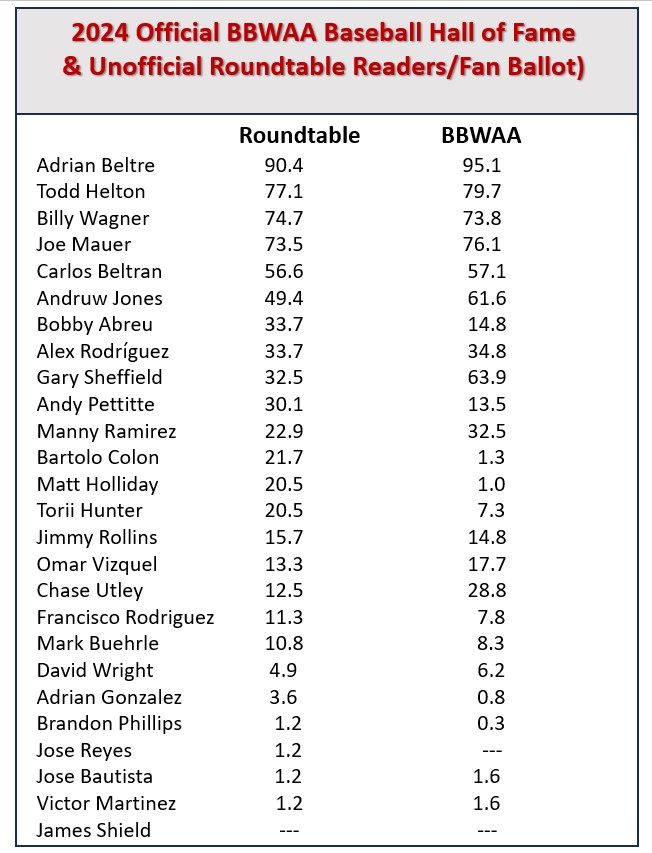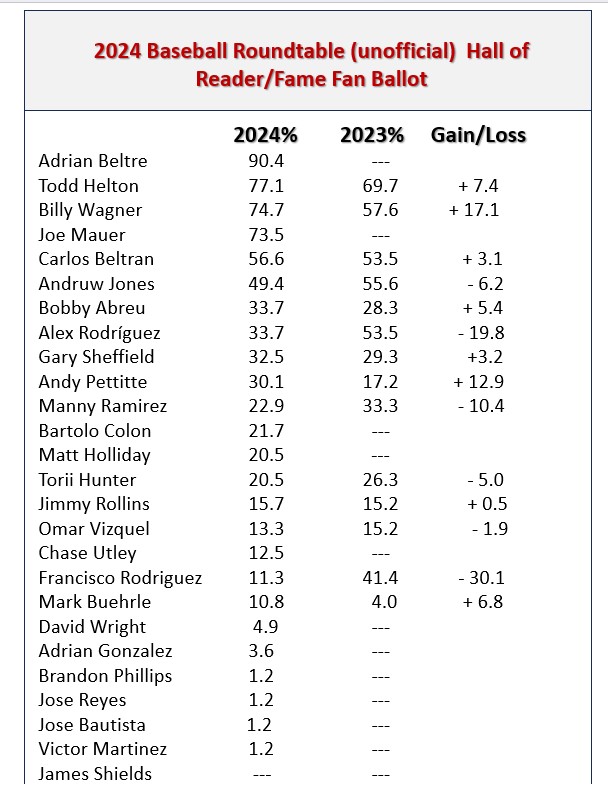As of the morning of April 17, 55 players had made their MLB debut thus far in the 2024 season. Twenty-nine of those were pitchers and eight were starters. Of those eight, Shota Imanaga had the most impressive debut outing, going six innings, giving up just two hits and fanning nine (no walks) in a 5-0 win over the Rockies. Six innings is the longest MLB debut outing by any pitcher so far this season.
That got to me to thinking about debut mound outings and how expectations and results have changed over time, I found that, in the Modern Era (post-1900), 472 pitchers have thrown a complete game of at least eight innings in their first MLB mound appearance. (I chose eight innings because, with a loss, you can throw a complete – non-weather or darkness-shortened – game – of eight innings. My choice of the Modern Era reflects issues with the availability and reliability of pre-1901 game logs.) The chart below shows how the handling of pitchers has changed over time. (At least as measured by MLB debut complete games.) Note: These numbers and the list at the end of this post may change a bit once Negro League game stats from 1920-48 are fully documented and incorporated into the MLB record books.
Now, 472 outings seemed like a lot of ground to cover. So, for this post, I limited myself to a look at pitchers who threw a shutout (of at least nine innings) in their first MLB trip to the mound. There were 67 of those. (There were also seven MLB debut shutouts of 5-to-7 innings.) The debut-game shutout list includes some familiar names, like Luis Tiant, Dave McNally, Juan Marichal and Schoolboy Rowe, as well as some less well-known monikers like Andy Van Hekken, Tot Pressnell, Tom Tuckey and Vitautis “Vito” Tamulis. I might add that a debut shutout does not offer much in the way of a prediction for the future. Of the 67 pitchers who three a nine-inning shutout in their debut, 30 finished their MLB career with more wins than losses; 29 with more losses than wins and eight with an even number of wins and losses. (Side note: Vito Tamulis pitched in six MLB seasons (1934-35, 1938-41 … Yankees, Browns, Dodgers, Phillies), going 40-23, 3.97. In his MLB debut – September 25, 1934 – for the Yankees – he shut out the Athletics 5-0, with a seven hitter (one walk/five strikeouts.)
Notably, for six of those pitchers, that debut shutout proved to be their only MLB victory.
 The most recent MLB debut shutout was tossed by The Tigers’ 23-year-old southpaw Andy Van Hekken on September 3, 2002 (yes, more than twenty years ago), as the Tigers topped the Indians 4-0 in Detroit. Van Hekken went nine innings, gave up eight hits and two walks and, surprisingly, fanned just one. Notably, Van Hekken is also the most recent pitcher to open his MLB career with a complete game of any kind.
The most recent MLB debut shutout was tossed by The Tigers’ 23-year-old southpaw Andy Van Hekken on September 3, 2002 (yes, more than twenty years ago), as the Tigers topped the Indians 4-0 in Detroit. Van Hekken went nine innings, gave up eight hits and two walks and, surprisingly, fanned just one. Notably, Van Hekken is also the most recent pitcher to open his MLB career with a complete game of any kind.
Van Hekken’s gem was not a portent of things to come. In 2002, he pitched in four more games (all starts), going 0-3, 4.29. He was back in the minors to open the 2003 season and never pitched in the major leagues again (although he did pitch professionally (minor leagues, independent, Japan, Korea, China). In 2023, he was hired as pitching coach for Calvin University.
In 13 minor-league seasons, Van Hekken went 105-72, 3.89, logging more than 1,500 innings. He also pitched more than 1,000 frames in foreign leagues. He is one of just six pitchers to throw a shutout in their MLB debut and never log another MLB victory.
Among the hurlers tossing debut whitewashes, Juan Marichal logged the most MLB wins – going 243-142 over 16 seasons.
—Baseball Roundtable Rates the Most Impressive/Interesting MLB Debut Shutouts—
Here are Baseball Roundtable’s favorite debut shutouts.
One: Doing It All – On the Mound and At the Plate … Jason Jennings
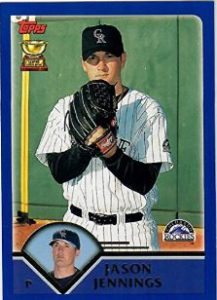 On August 23, 2001, Colorado Rockies’ 22-year-old rookie right-hander Jason Jennings made his first MLB appearance – a start on the mound against the New York Mets (in New York). Jennings – a 1999 first-round draft pick – did not disappoint. After a slow start (a single and a walk to the first two batters he faced), Jennings settled in. In that first big-league appearance, he went the distance – tossing a complete-game, five-hit (four walks/eight strikeouts) shutout.
On August 23, 2001, Colorado Rockies’ 22-year-old rookie right-hander Jason Jennings made his first MLB appearance – a start on the mound against the New York Mets (in New York). Jennings – a 1999 first-round draft pick – did not disappoint. After a slow start (a single and a walk to the first two batters he faced), Jennings settled in. In that first big-league appearance, he went the distance – tossing a complete-game, five-hit (four walks/eight strikeouts) shutout.
He did alright at the plate, as well, again after a slow start. The left-handed hitter popped up to third in his first at bat (ending the first inning, when the Rockies gave him a three-run cushion). Then, in the top of the fourth, he singled to left; in the fifth, he grounded to first; in the seventh he stroked an RBI single to center; and he topped of his first game with a leadoff home run in the top of the ninth. His day? Three-for-five, one run scored, two RBI and a home run – and, of course, that shutout.
The Rockies’ Jason Jennings is the only Modern-Era pitcher to toss a shutout and hit a home run in his MLB debut.
Jennings ended his first MLB campaign 4-1, 4.58 in seven starts and .267-1-2 at the plate. He continued to deliver on that first impression in 2012, when he went 16-8, 4.52 in 32 starts for the Rockies – and won the National League Rookie of the Year Award. That made him 20-9, 4.53 for his first two MLB seasons. He also improved his results at the plate in 2002, raking at a .306 pace (19-for-68), with four doubles and 11 RBI in 30 games.
Jennings’ run, however, did not continue – as he went on to face some control issues as well as elbow problems. The 2002 season was his final .500 or better campaign and, over his final seven seasons (Rockies, Astros, Rangers), Jennings went 42-65, with a 5.06 earned run average. He did notch five more complete games, two more shutouts and a second home run. His final stat line for nine seasons? Pitching: 62-74, 4.95. Batting: .207-2-26.
Doing It All In Other Ways
Jason Jennings, selected by the Rockies in the first round of the 1999 MLB draft (16th overall), was a star in both high school and college. He was All-District in high school (Poteet HS –Mesquite, TX) football as a punter/place-kicker and an outstanding pitcher and hitter in baseball (named District Most Valuable Player as a senior when he hit .410 and went 10-3, 0.92 on the mound). He played baseball at Baylor University from 1997-99 and, in 1999, was named the National College Player of the Year by “Baseball America” and “Collegiate Baseball.” A three-time All-American, Jennings was elected to the Baylor University Hall of Fame (2009).
Two: A Whiff Master … Karl Spooner
 Southpaw Karl Spooner was called up to the Dodgers in late 1954 – after going 21-9, 3.14 for the Double-A Fort Worth Cats. He was an immediate sensation – pitching a complete-game, three-hit shutout against the rival Giants in his September 22, 1954 debut. In the 3-0 win, Spooner walked three and fanned 15 batters – still the MLB record (since tied) for a pitcher in his first MLB appearance.
Southpaw Karl Spooner was called up to the Dodgers in late 1954 – after going 21-9, 3.14 for the Double-A Fort Worth Cats. He was an immediate sensation – pitching a complete-game, three-hit shutout against the rival Giants in his September 22, 1954 debut. In the 3-0 win, Spooner walked three and fanned 15 batters – still the MLB record (since tied) for a pitcher in his first MLB appearance.
Spooner, notably, did not get off to a great start – giving up a single and two walks in the first frame – but pitching out of trouble. Not a single batter reached second base after the first inning and in the seventh and eighth, Spooner faced the minimum six batters and fanned them all (swinging) on a total of 29 pitches. Spooner cemented the number-two spot on this list (whether it’s a fair way to “score” or not) with his second MLB appearance – another complete-game shutout. This time a four-hit, 1-0 win over the Pirates (September 25) in which he walked three and fanned a dozen. So, in his first two MLB appearance, Karl Spooner did not give up a run and fanned 27 batters in 18 innings – in a season in which the average strikeouts per nine innings among MLB pitchers was 4.2. Side note: The Astros’ J.R, Richard tied Spooner’s record of 15K in an MLB debut (September 5, 1971), but gave up three runs (two earned) in his outing.
Clearly, with Spooner, it looked like the Dodgers had an “ace” in the making. That, however, was not to be. In 1955, a Spring Training shoulder injury took its toll and Spooner pitched only 98 2/3 innings that season – going 8-6, 3.65 in 29 appearances (14 starts). He spent the next three seasons in the minor leagues, before retiring at age 27. His MLB career (1954-55 … Dodgers) stat line was 10-6, 3.09, with 105 strikeouts in 116 2/3 innings.
A Roundtable Extra – Pre-1900
Charles “Bumpus” Jones is the answer to a baseball trivia question – “Who is the only major leaguer to throw a complete-game, no-hitter in his very first MLB appearance?” At first glance, one might be tempted to reply “Bobo Holloman” – but, while Bobo threw a no-no in his first MLB start, it was preceded by four relief appearances. Bumpus, however, threw a no-hitter in his first-ever MLB mound appearance. It came on October 15, 1892 (the final day of the season) against the Pittsburgh Pirates. Jones walked four and struck out three in the game – a 7-1 Reds’ win. The only Pirates’ run scored in the third inning on a walk, a stolen base and an error by Jones
Three: One Strike Short of History … Billy Rohr
Red Sox’ lefty Billy Rohr finishes this high on this list based on the pressure of the moment. The 21-year-old made his debut (April 14, 1967) against the Red Sox’ rival Yankees, at the New Yorkers’ 1967 home opener, and his mound opponent was Yankee ace, hero and future Hall of Famer Whitey Ford.
How did the rookie handle the pressure? Well, with two out in the bottom of the ninth, he was protecting a 3-0 lead and had yet to give up a hit (five walks, two strikeouts). In addition, he was dealing with the effects of a sixth-inning line drive off the bat of Yankee’s RF Bill Robinson that had ricocheted off Rohr’s shin to third baseman Joe Foy who threw to first for the out. Rohr had to argue with manager Dick Williams to stay in the game. Now, with two down in the ninth, all that stood between Rohr and a no-hitter was Yankee catcher Elston Howard. Rohr got ahead of Howard 1-2 and was one strike away from a no-hitter in his first MLB appearance. The next pitch was called a ball (Red Sox catcher Russ Gibson would forever maintain it was a strike). Then, on a 2-2 count, Howard hit a soft, looping liner over second baseman Reggie Smith – putting an end to the no-hitter. On the very next pitch, Yankees’ 3B Charley Smith flied out to right and Rohr had a one-hit shutout in his MLB debut.
One week later (April 21), Rohr made his second major-league appearance. Again, he faced the Yankees, this time in Boston. He sparkled once more, holding a 6-0 lead after seven innings. The New Yorkers finally scored off the rookie in the eighth, on an RBI single by Rohr’s debut nemesis Elston Howard.
So, after two MLB appearances, Rohr was 2-0, with two complete games and 0.50 earned run average. It looked like the youngster was on his way. He was not. Rohr made eight more appearances (six starts) through June 1, going 0-3, 7.71, before being sent back down to Triple- A. (He did make one more appearance, in relief, for Boston in September.) Early in the 1968 season, he was sold to the Indians, where he went 1-0, 6.87 in 17 relief appearances. He made his last MLB appearance on June 26, 1967, although he did toil in the minors until 1972. After that 2-0, 0.50 start, Rohr ended with an MLB line (1967-68 … Red Sox) of 3-3, 5.64. Rohr, by the way, was originally signed by the Pirates out of Bellflower (CA) High school, where he went 23-6 with four no-hitters.
Four: Youth Will Be Served … Lew Krausse Jr.
The youngest player to throw nine-inning shutout was Lew Krausse, Jr. (18 years-52 days) of the 1961 Kansas City Athletics – and he did it in his MLB debut, just ten days after graduating from high school. That made plenty of noise on the impression-meter for me. In his June 16, 1961 MLB debut, Krausse pitched three-hit, five-walk, six-whiff shutout in a 4-1 win over the Angels. He finished that season at 2-5, 4.85 in 12 appearances (eight starts).
Graduating With Honors
Research by Society for American Baseball Research member Larry DeFillipo shows that in his last two high school seasons, Lew Krausse, Jr. went 13-1, 0.09 (yes, the decimal point is in the right place), fanning just over 20 hitters per nine innings.
Control issues and elbow surgery delayed Krausse’s MLB progress and it wasn’t until 1966 that he found a full-time spot on the A’s staff, going 14-9, 2.99. He ultimately pitched in 12 MLB seasons (Athletics, Brewers, Red Sox, Cardinals, Braves), going 68-91. 4.00
Five: Russ Van Atta, LHP, Yankees April 25, 1933 … A Shutout and Four Hits
 Russ Van Atta was a pitching star at Penn State, where he reportedly lost only one game in four college seasons (before signing with the Yankees in 1928). Van Atta pitched in the minors from 1928 through 1932 (four years with the Double-A American Association Saint Paul Saints, where he went 22-17 in 1932). He made his debut for the Yankees on April 25, 1933, facing the Washington Senators. (Note: These were not the Senators of later years. In 1933, the Senators went 99-53-1 and finished first in the American League.)
Russ Van Atta was a pitching star at Penn State, where he reportedly lost only one game in four college seasons (before signing with the Yankees in 1928). Van Atta pitched in the minors from 1928 through 1932 (four years with the Double-A American Association Saint Paul Saints, where he went 22-17 in 1932). He made his debut for the Yankees on April 25, 1933, facing the Washington Senators. (Note: These were not the Senators of later years. In 1933, the Senators went 99-53-1 and finished first in the American League.)
In his debut, Van Atta threw a five-hit shutout (three walks, five strikeouts) as his Yankees won 16-0. Not only that, he went four-for-four (all singles) at the plate, scoring three runs and driving in one. Van Atta had as many hits in the game as teammates Babe Ruth and Lou Gehrig combined.
Van Atta finished his rookie season 12-4, 4.18, in 26 games (22 starts) with ten complete games – and with a .283 average in 60 at bats.
Van Atta looked to be on the cusp of a solid MLB career, only to see it derailed by a “unique” injury. Between the 1933 and 1934 seasons, he injured the index finger on his pitching hand rescuing a dog from a home fire – and it affected his mound performance. He went 3-5, 6.34 in 1934 (28 games, nine starts). After that season, he was primarily a relief pitcher – leading the AL in appearances in 1935 and 1936. Van Atta had a seven-season MLB career (1933-39 … Yankees, Browns) and went 33-41, 5.60. As a batter, he went .228-2-17 in 206 at bats.
Six: Taking a Perfect Game into the Seventh … Juan Marichal
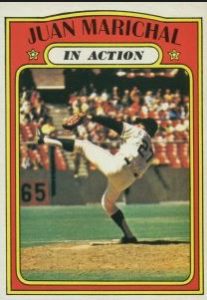 Juan Marichal was signed by the Giants in 1958 as a 20-year-old out of the Dominican Republic – and made his MLB debut (at age 22) on July 19, 1960. When called up, he was 11-5, 3.11 in 18 Triple-A starts for the season. The future Hall of Famer showed his credentials as “The Dominican Dandy” right from that very first appearance. He tossed a complete-game, one-hit shutout against the Phillies in San Francisco. Allowing just one walk and fanning a dozen (the Giants won 2-0). He retired the first 19 MLB batters he ever faced (until a seventh-inning error by SS Eddie Broussard put Phillies’ 2B Tony Taylor on base). The first hit against Marichal didn’t come until there were two outs in the eighth (a single by catcher Clay Dalrymple). In the game, only one Phillie reached second base. In his first three MLB starts, Marichal tossed three complete-game victories (one a ten-inning contest) and gave up just three runs in 29 frames.
Juan Marichal was signed by the Giants in 1958 as a 20-year-old out of the Dominican Republic – and made his MLB debut (at age 22) on July 19, 1960. When called up, he was 11-5, 3.11 in 18 Triple-A starts for the season. The future Hall of Famer showed his credentials as “The Dominican Dandy” right from that very first appearance. He tossed a complete-game, one-hit shutout against the Phillies in San Francisco. Allowing just one walk and fanning a dozen (the Giants won 2-0). He retired the first 19 MLB batters he ever faced (until a seventh-inning error by SS Eddie Broussard put Phillies’ 2B Tony Taylor on base). The first hit against Marichal didn’t come until there were two outs in the eighth (a single by catcher Clay Dalrymple). In the game, only one Phillie reached second base. In his first three MLB starts, Marichal tossed three complete-game victories (one a ten-inning contest) and gave up just three runs in 29 frames.
Marichal pitched 16 MLB seasons (1960-75 … Giants, Red Sox, Dodgers), going 243-142, 2.89. He was an All Star in nine seasons and a seven-time winner of 20+ games. Despite seasons of 25-8, 2.41 (1963), 25-6, 2.23 (1966) and 26-9, 2.43 (1968), he never won a Cy Young Award. In fact, he did not get a single CYA vote in any of those three seasons. The unanimous winners were Sandy Koufax in 1963 and 1966 and Bob Gibson in 1968.
Seven: Up to the Task … Elmer Myers
Elmer Meyers had a big hill to climb (see what I did there) in his October 6, 1915 MLB debut. The right-handed Philadelphia Athletics’ rookie was facing the Washington Nationals, with an 85-67 record, while his Athletics were 42-109. The 21-year-old rookie, called up for a start after a 29-10 season for the Class-D Raleigh Capitols proved up to the task. Myers tossed a nifty two-hit (five walks), 12-strikeout shutout, as Philadelphia prevailed 4-0. Meyers went on to an eight-season (1915-22 … Athletics, Indians, Red Sox) MLB career, going 55-72, 4.06.
Eight: Start with a Shutout, Follow Up with a Shutout … Al Worthington
Al Worthington made a name for himself in the major leagues as a reliever – running off a string of seven seasons of double-digits in saves and leading the AL with 18 saves for the Twins in 1969. Worthington gets irony points here, since the respected reliever made this list by virtue of throwing two, complete-game shutouts in his first two MLB appearances. The 24-year-old was in his third pro season and was 9-5, 2.90 for the Minneapolis Millers when he was called up by the Giants. In his MLB debut game on July 6, 1953, he shut down the Phillies on two hits (four walks, six whiffs) as his Giants won 6-0 in New York. Five days later he started again and shut out the Dodgers 6-0 on four hits (one walk, seven strikeouts). It was the only time the NL Champion Dodgers were shutout that season. Things went a little south after that, as his next eight decision were all losses (0-8, 5.13 in that span). He ended his rookie campaign at 4-8, 3.44. Worthington went on to a 14-season MLB career, going 75-82, 3.39 with 111 saves (533 relief appearances, 69 starts). He was 16-31, 3.99 as a starter and 59-51 (with those 111 saves), 3.11 as a reliever
Nine: Slow Joe Off to a Fast Start – Joe Doyle
Known as Slow Joe Doyle for his pace on the mound, Doyle made his MLB debut for the Highlanders (Yankees) on August 25, 1906, shutting out the Indians 2-0 (in New York) on six hits (two walks, five strikeouts). He followed it up August 30 with another complete-game shutout. This time a two-hitter (no walks, six strikeouts) as the Highlanders beat the Senators 5-0. He finished his rookie season at 2-1, 2.38 and went on to a five-season MLB career (1906-10) with a 22-21, 2.85 line.
Ten: Whew. That was a Close One … Jim Scott
Only a” lucky” 13 Modern-Era rookies have faced the tension of a 1-0 shutout victory in their MLB debut. only three of those had to wait until the ninth inning for their team to sore and only one – Number Ten on this list – saw the winning run cross the plate in the bottom of the ninth.
Jim Scott debuted for the White Sox, against the Browns, on April 25, 1909. Scott gave up just three singles and wo walks in his debut, fanning six. His white Sox managed just four singles (six walks) and that lone run in the bottom of the ninth – scored by Freddy Parent on a Browns’ fielding error.
Scott went on to pitch in nine MLB seasons (1909-17) all for the White Sox He went 107-114, 2.30, with his best season coming in 1915, when he went 24-11, 2.03. He was better than his W-L record would indicate, finishing in the league’s top ten: three-times in earned run average; four times in strikeouts; five times in strikeouts per nine innings; four times in shutouts; twice in Walk+Hits Per Nine innings; four times in games started; and twice in complete games.
A Tough Loss
On May 14, 1914, Jim Scott pitched nine no-hit innings for the White sox (versus Nationals, but gave up two hits and one run in the tenth to take a loss.
Eleven: A Pair of Five-Hitters … Johnny Marcum
The Philadelphia Athletics called up 23-year-old Johnny Marcum in September of 19-33 – after a 20-13, 3.74 season for the Double-A Louisville Colonels. He showed his “stuff” right away. In his first appearance, September 7, he tossed a five-hit (six walks, four whiffs) shutout, as the Athletics topped the Indians 6-0 in Philadelphia. He started again on the 11th and tossed another five-hit shutout (three walks, three whiffs) as the Athletics topped with White Sox 8-0. He finished his rookie season at 3-2, 1.70 and went 65-63 in a seven-season (1933-39) MLB career.
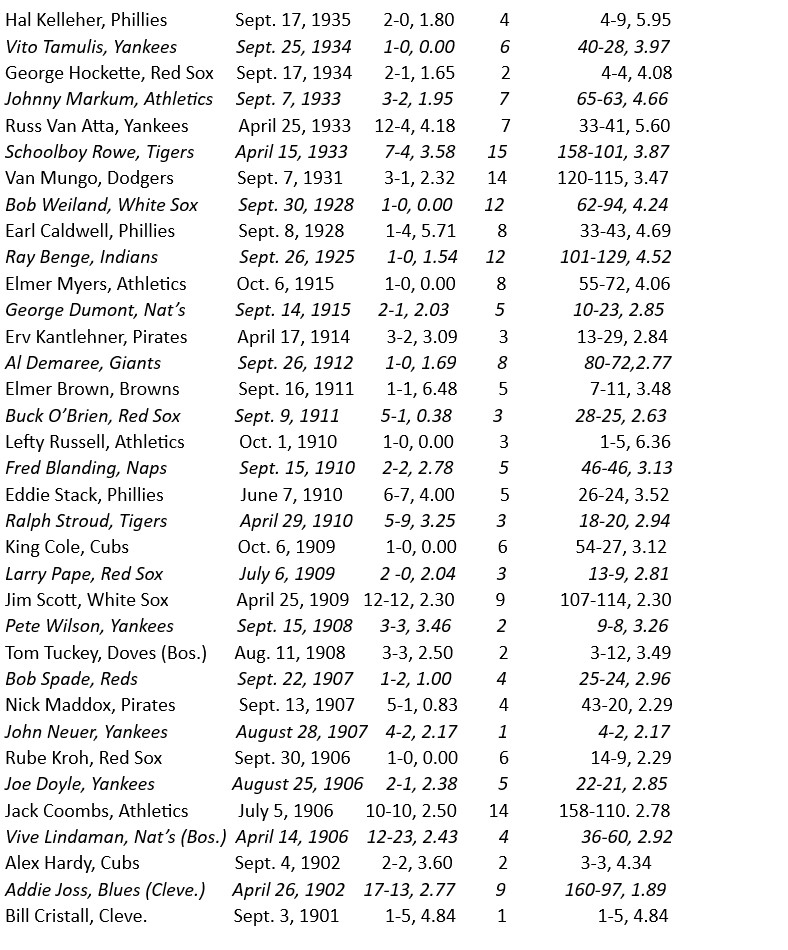
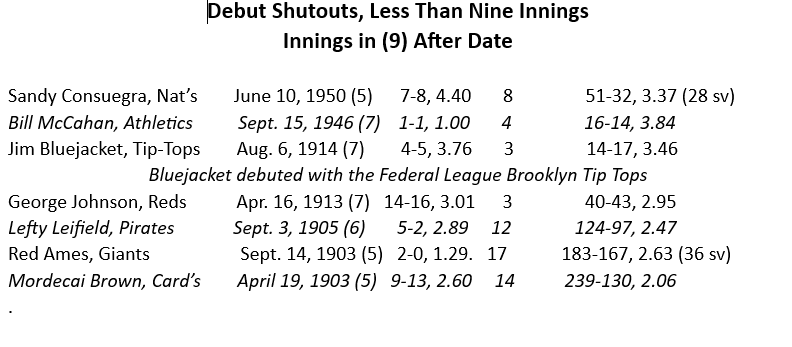 Primary Resources: Baseball-Reference.com; Baseball-Almanac.com; the following SABR bios: Bumpus Jones, by Chris Rainey; Fred Clarke, by Angelo Luisa; Billy Rohr, by Alexander Edelman; “A Most Spectacular Debut” (Russ Van Atta), by Randolph Linthurst.” June 16, 1961: Lew Krausse twirls debut shoutouts 10 tens after High-school graduation”, Larry Defillipo, Society for American Baseball Research.
Primary Resources: Baseball-Reference.com; Baseball-Almanac.com; the following SABR bios: Bumpus Jones, by Chris Rainey; Fred Clarke, by Angelo Luisa; Billy Rohr, by Alexander Edelman; “A Most Spectacular Debut” (Russ Van Atta), by Randolph Linthurst.” June 16, 1961: Lew Krausse twirls debut shoutouts 10 tens after High-school graduation”, Larry Defillipo, Society for American Baseball Research.
Baseball Roundtable – Blogging Baseball Since 2012.

 Baseball Roundtable is on the Feedspot list of the Top 100 Baseball Blogs. To see the full list, click here.
Baseball Roundtable is on the Feedspot list of the Top 100 Baseball Blogs. To see the full list, click here.
Baseball Roundtable is also on the Anytime Baseball Supply Top 66 Baseball Sites list. For the full list, click here.
I tweet (on X) baseball @DavidBaseballRT
Follow Baseball Roundtable’s Facebook Page here. More baseball commentary; blog post notifications.
Member: Society for American Baseball Research (SABR); Negro Leagues Baseball Museum; The Baseball Reliquary.
P1032

